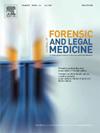Optimizing the detection and characterization of bruises using multispectral imaging
IF 1.2
4区 医学
Q3 MEDICINE, LEGAL
引用次数: 0
Abstract
The detection and visualization of sub-dermal hematoma (bruises) plays a key role in suspected physical abuse cases, as it aids in the evaluation of both victim and suspect statements. Current methods rely on visual inspection, frequently aided by alternate light sources (ALS). Ideally, ALS increase visual contrast by exploiting differences in light absorption (due to the formation and clearance of chromophores within the bruise). However, in practice the achievable contrast is often limited by light-scattering: the short-wavelength region of the spectrum (comprising most of the chromophore-specific absorption peaks), is also strongly scattered by the dermal tissue. This, in turn, limits achievable penetration depths, effectively obscuring deep-lying bruises. ALS-based contrast enhancement is further complicated by bruise healing; diffusion and enzymatic activity alter the chromophore concentrations as well as their 3D-distribution within the tissue. To overcome these critical limitations, we employ a multi-spectral camera (8 wavelengths simultaneously) in conjunction with both observer-based scoring and a contrast-quantification algorithm to determine the optimal wavelength for the detection and characterization of bruises over time. We show that (i) bruise contrast significantly increases at 480 nm, 620 nm and 850 nm and (ii) the wavelength achieving optimal contrast gradually changes from 850 nm to 578 nm–480 nm as the bruise heals.
优化检测和表征瘀伤使用多光谱成像
真皮下血肿(瘀伤)的检测和可视化在疑似身体虐待案件中起着关键作用,因为它有助于评估受害者和嫌疑人的陈述。目前的方法依赖于视觉检查,经常辅以备用光源(ALS)。理想情况下,ALS通过利用光吸收的差异(由于瘀伤中发色团的形成和清除)来增加视觉对比度。然而,在实践中,可实现的对比往往受到光散射的限制:光谱的短波长区域(包括大多数发色团特异性吸收峰)也被皮肤组织强烈散射。这反过来又限制了可达到的穿透深度,有效地掩盖了深层的瘀伤。基于als的对比增强因瘀伤愈合而进一步复杂化;扩散和酶活性改变发色团浓度以及它们在组织内的3d分布。为了克服这些关键的限制,我们采用了多光谱相机(同时8个波长),结合基于观察者的评分和对比量化算法,以确定随时间推移检测和表征瘀伤的最佳波长。我们发现(i)在480 nm、620 nm和850 nm处挫伤对比度显著增加,(ii)随着挫伤愈合,达到最佳对比度的波长从850 nm逐渐变化到578 nm - 480 nm。
本文章由计算机程序翻译,如有差异,请以英文原文为准。
求助全文
约1分钟内获得全文
求助全文
来源期刊

Journal of forensic and legal medicine
MEDICINE, LEGAL-
CiteScore
2.70
自引率
6.70%
发文量
106
审稿时长
57 days
期刊介绍:
The Journal of Forensic and Legal Medicine publishes topical articles on aspects of forensic and legal medicine. Specifically the Journal supports research that explores the medical principles of care and forensic assessment of individuals, whether adult or child, in contact with the judicial system. It is a fully peer-review hybrid journal with a broad international perspective.
The Journal accepts submissions of original research, review articles, and pertinent case studies, editorials, and commentaries in relevant areas of Forensic and Legal Medicine, Context of Practice, and Education and Training.
The Journal adheres to strict publication ethical guidelines, and actively supports a culture of inclusive and representative publication.
 求助内容:
求助内容: 应助结果提醒方式:
应助结果提醒方式:


